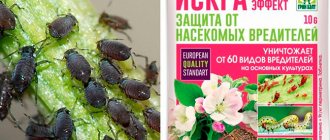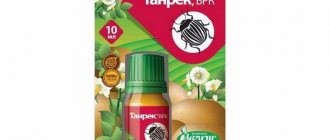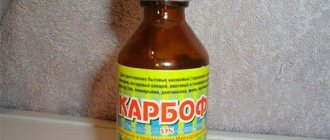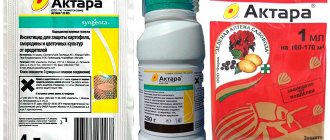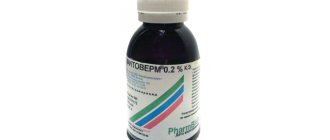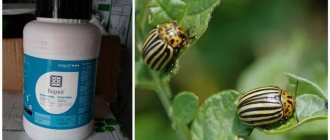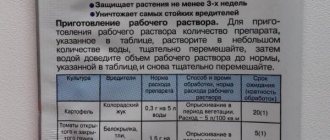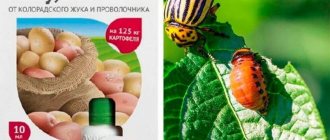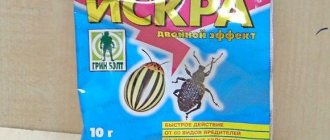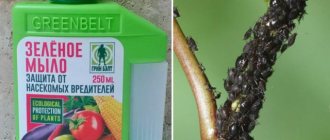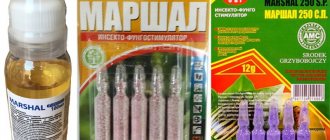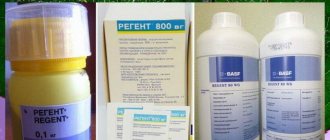Author: Elena N. https://floristics.info/ru/index.php?option=com_contact&view=contact&id=19 Category: Insecticides Published: February 28, 2012Republished: February 28, 2019Last edits: March 12, 2021
If you find several types of pests on your flowers, vegetables or fruit crops, you will need a broad-spectrum product to get rid of them. One of the most effective products in this category of insecticides is Mospilan, developed by the Japanese manufacturer Nippon Soda Co., Ltd. It will be especially interesting to those gardeners who keep bees. We will tell you more about this drug.
Chemical composition of the drug Mospilan and release form
This insecticidal drug is produced by a company from Japan, Nippon Soda.
The main active ingredient in Mospilan is acetamiprid from the neonicotinoyl group. The amount of active ingredient in Mospilan is 200 g/kg. The drug is produced:
- in foil bags weighing 2, 5, 10 and 15 g;
- in packs of 200 and 1000 g.
Important!
When purchasing the drug, you need to be careful, since recently cases of counterfeiting of this effective insecticide have become more frequent.
Compatibility
To prepare tank mixtures of Mospilan with neutral or slightly acidic agrochemicals that do not contain sulfur (see above), you must first do a compatibility test. In a shaded room, 50-100 ml of working solutions are prepared, poured into a clean glass container and left for an hour in the dark or semi-darkness. If signs of a chemical reaction are detected (change in temperature and/or color of the mixture, cloudiness, formation of flakes and/or sediment, bubbles, foam) – the drugs are incompatible. But this is not a guarantee of compatibility: using homemade methods, the incompatibility of pesticides is accurately determined only by the lack of a protective effect.
What pests does Mospilan insecticide affect?
This drug is effective against the following “harmful” bugs that affect garden and vegetable crops in open and closed ground:
- Colorado potato beetles;
- apple sawflies and codling moths;
- aphids;
- weevils;
- scale insects;
- thrips;
- whiteflies.
Photo of the weevil pest:
Thanks to the active substance included in the drug, Mospilan effectively destroys adults, their larvae, and eggs.
How the drug works
The Mospilan product gets on the foliage, penetrates inside and, together with the cell sap, spreads along the shoots and roots.
Pests feed on poisoned leaves, then the toxins enter their body and disrupt the functioning of the nervous system, resulting in paralysis, the insects cannot eat and quickly die. The poison also penetrates the chitinous cover of insects when they crawl on insecticide-treated leaves.
The first signs of poisoning appear in insects within 60 minutes after treatment of plants, and complete death of pests can occur within a day (but no later than 2 days from the moment of spraying).
Mechanism of action of the product
Acetamiprid has a nerve-paralytic effect on insects. The substance blocks the passage of impulses through synapses. The death of pests occurs after overexcitation and paralysis. Agrochemicals of the neonicotinoid group penetrate into plant leaves and accumulate in them. The poisonous effect occurs when eating treated leaves and stems.
The agricultural product is effective at any stage of development of pest organisms: eggs, larvae, mature individuals. Non-phytotoxic, used for flowering rapeseed and fruit trees.
The main advantages of the insecticide
Mospilan insecticide is universal and protects most garden and garden crops from all forms of insect pests.
The main advantages of Mospilan:
- effectively fights pests even at abnormally high temperatures;
- provides protection to treated plants for up to 3 weeks;
- destroys all forms of pests, prevents the emergence of new “harmful” bugs;
- Insects do not develop resistance to this drug, so it can be used several times a season to treat cultivated plants;
- able to fight pests even in hard-to-reach places;
- efficiency;
- the drug does not have an unpleasant odor.
Principle of operation
The insecticide Mospilan penetrates the tissue of the plant when it comes into contact with it from the outside anywhere and quickly spreads through the vascular system to all its parts, including the roots. This is a drug with enteric contact action. It is destructive for pests both in direct contact with the solution and when feeding on the tissues and sap of the treated plant.
Acetamiprid is a nerve poison for insects. It “inhibits” the activity of their nervous system, preventing the transmission of nerve impulses, and “inhibits” the production of enzymes necessary for the normal course of all biological processes. The inevitable consequence is convulsions, spasms, the inability of the insect to move and its death within 24 hours.
The main disadvantages of the Mospilan insecticide
Despite a number of obvious advantages, this drug also has disadvantages that you need to be aware of:
- Mospilan is toxic to pollinating insects and inhabitants of water bodies, so it should not be sprayed during the flowering period of garden and vegetable crops, near apiaries and water bodies;
- During treatments, children and pets must be removed from the area;
- the need to comply with the dosage of the drug so that the product does not harm plants and the environment.
Storage
Original Mospilan can be stored for 36 months in unopened packaging. in a dark place (all neonicotinoids are subject to photolysis). In reality, the powder can be taken in parts over 2 seasons from a tightly sealed, vapor-tight container if the drug is stored in a dry room (neonicotinoids are also subject to hydrolysis). The remaining storage conditions are usual for pesticides: locked away from children and animals in a separate non-residential area in which food products are not stored. The permissible storage temperature range for Mospilan is +(5-30) degrees Celsius.
Note: how to divide a package or large sample of powder into small doses without precise scales, see the video below:
Video: how to measure the required amount of the drug
Mospilan: use of the drug for specific crops
This insecticidal preparation can be used for spraying cultivated plants in the open ground, as well as in greenhouses.
For treatments to be effective, certain dosages must be adhered to when spraying plants. Usually, in order to cope with pests, vegetable and grain crops are sprayed with Mospilan once, and to treat fruit trees it is necessary to apply the insecticide twice.
Treatment of potatoes with Mospilan
Potatoes should be treated with Mospilan against the Colorado potato beetle
. Usually, potato tubers prepared for planting are soaked in a solution of the drug, and the bushes of this vegetable crop are also sprayed after flowering.
The working liquid for processing potatoes is prepared as follows: 2 g of Mospilan is dissolved in 1 liter of water, mixed well, then the total amount of water is brought to 10 liters and the tubers are processed or soaked.
In order to process 1 square of potato plantation, 5 liters of working fluid are required.
Mospilan against whitefly in greenhouses
To treat plants in protected soil against whiteflies, prepare the following working solution: dissolve 2 g of the product in 4 liters of water.
You can also use a dry preparation - its granules are simply scattered in the root zone of plants.
Mospilan for grain crops
To protect wheat from attack by “harmful” bugs, it is necessary to spray the plantings 30 days before harvest. Insecticide consumption is 100 g per hectare of area.
Mospilan for processing tomatoes and cucumbers
These vegetable crops are treated with the insecticidal drug Mospilan against the following pests:
- whiteflies;
- aphids;
- thrips.
To treat a hectare of tomatoes or cucumbers, 200 g of the drug is required.
For beets
To treat plantings of this root crop with the Mospilan insecticide against pests, 50 to 75 g of product per hectare of area is required.
Mospilan for sunflower
To treat sunflower against pests, the same amount of preparation is required as for beets.
Treatment of apple trees with Mospilan
Apple trees are treated with Mospilan insecticide against the following pests:
- aphids;
- codling moths;
- moth;
- leaf rollers.
For preventive purposes, apple trees are sprayed with Mospilan in the spring, and no more than two treatments can be carried out.
The last spraying is carried out before the ovaries form on the trees. To spray these fruit trees, 200-400 g of product per hectare is required.
Consumption rate per 10 liters for specific plants
On average, 10 liters of working solution of Mospilan insecticide is enough to treat 200-250 m² of bed area. The consumption of the drug for such a volume of water is determined by the type of pest that has to be combated. Therefore, we can only talk about approximate standards.
| Culture | Consumption of Mospilan insecticide per 10 l |
| Cereals | Up to 15 g |
| Cucumbers, tomatoes | Up to 20 g |
| Potato | 5-12.5 g |
| Beet | 5-7.5 g |
| Sunflower | 5-7.5 g |
| Apple trees and other fruit trees | 20-40 g |
| Houseplants | 2.5-5 g |
Hazard class and precautions
The Mospilan insecticide belongs to hazard class 2, so it cannot be used near an apiary or pond, and plantings should not be sprayed with this drug during the flowering of garden and vegetable crops.
During treatments with Mospilan, the following precautions should be observed:
- spraying is carried out in the morning or evening hours in clear, windless weather;
- During the procedure, you should wear protective equipment to protect your nasopharynx, eyes and hands from contact with the working fluid;
- do not eat, drink or smoke during spraying;
- the processing time should not exceed 4 hours;
- To prepare the working fluid, the use of food containers is not allowed; the solution is mixed only in plastic or glass containers.
After finishing the treatment, you should wash your face and hands, wash your clothes, and take a shower.
If drops of the solution get on the skin, they must be carefully removed using cotton pads, then rinse the affected areas under running water. The mucous membranes on which the insecticide has come into contact are also washed with cool running water.
If the product gets inside, you need to drink a large amount of water, induce vomiting, then drink several tablets of activated carbon. If you feel unwell, consult a doctor immediately.
First aid
The recommendations below are intended only for providing FIRST aid, after which you should immediately consult a doctor and follow his instructions! DO NOT SELF-medicate!
- If the drug gets into your eyes, they should be rinsed while open with plenty of running water.
- If the drug enters the digestive system, you should take activated carbon at the rate of 1 tablet per 10 kg of body weight and wash down the tablets with two to three glasses of water, after which you must induce vomiting.
- If the drug gets on the skin, blot it with a cloth or cotton wool, being careful not to rub it, and wash the area with soapy water.
- Providing first aid does not relieve you from the need to see a doctor! There is no antidote for Mospilan, so treatment of poisoning with the drug is symptomatic.
Insecticide Mospilan: reviews of those who have used this drug
Maria, 45 years old, Samara My husband and I are growing potatoes for sale in our garden.
This crop is most affected by the Colorado potato beetle. We used various insecticides to combat it. But Mospilan turned out to be the most effective - the beetles died after the first treatment and did not appear on the potatoes again until the end of the season. An excellent insecticide, I recommend it to everyone. Olga, 38 years old, Volgograd region Aphids have appeared on the cucumbers that I grow in my garden beds. I tried to get rid of it using folk remedies, but they turned out to be not very effective, since there were already a lot of these pests. As a result, I had to use “chemistry”, although I am not very fond of such products. I sprayed the cucumbers with Mospilan insecticide. As a result, all the aphids died, and new ones did not appear. Tatyana, 59 years old, Penza Aphids settled on my apple trees last season, and codling moths also appeared. I had to resort to spraying the crown with the Mospilan insecticide. I carried out a couple of treatments at intervals of a couple of weeks to ensure that all pests were eliminated. I can say that Mospilan is indeed very effective - all the pests died after about two days, as was written in the instructions for use. This insecticide is a universal preparation and destroys all forms of major pests that attack cereals, vegetables and horticultural crops. When diluting the product, it is important to follow the dosage of the Mospilan insecticide so as not to harm plants and the environment.
Let's think about the future
Mospilan, like imidacloprid (the basis of Iskra Zolotoy and Kofidor), at the first time of its use seemed environmentally safe in the long term, because does not contain sulfur, phosphorus, or metals that give long-term negative after-effects. But its deadly effect on insects has already led to a quiet but severe environmental disaster in some Western countries. There is a lot of space and wildlife in Russia, but not an infinite amount. It is immeasurably more difficult to control the environmental impact of many small farms than large areas. Therefore, it is highly desirable for private farmers to limit the use of the Mospilan insecticide to greenhouse farming. Mospilan can be “released” into the garden for a season or two to get rid of leaf miners. And in the field - if there are potato bugs in large numbers. Which, of course, is better not to do.
Final note: when working with Mospilan in a greenhouse, the use of PPE that completely excludes contact of the drug with the worker’s body is mandatory!
